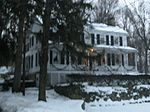Boalsburg, Pennsylvania

Boalsburg is an unincorporated community and census-designated place (CDP) in Harris Township, Centre County, Pennsylvania, United States. It is part of the State College, Pennsylvania Metropolitan Statistical Area. The population was 3,722 at the 2010 census. The village claims to be the birthplace of Memorial Day. However, that claim was brought into question by Bellware and Gardiner in their book, The Genesis of the Memorial Day Holiday in America, in 2014. In their book, Bellware and Gardiner point out that the Boalsburg story was first published in 1904, forty years after the fact with no indication that General Logan drew inspiration from any activities in Boalsburg and no evidence that it started the holiday.
Excerpt from the Wikipedia article Boalsburg, Pennsylvania (License: CC BY-SA 3.0, Authors, Images).Boalsburg, Pennsylvania
Beacon Circle,
Geographical coordinates (GPS) Address Nearby Places Show on map
Geographical coordinates (GPS)
| Latitude | Longitude |
|---|---|
| N 40.782777777778 ° | E -77.786944444444 ° |
Address
Beacon Circle 273
16827
Pennsylvania, United States
Open on Google Maps










